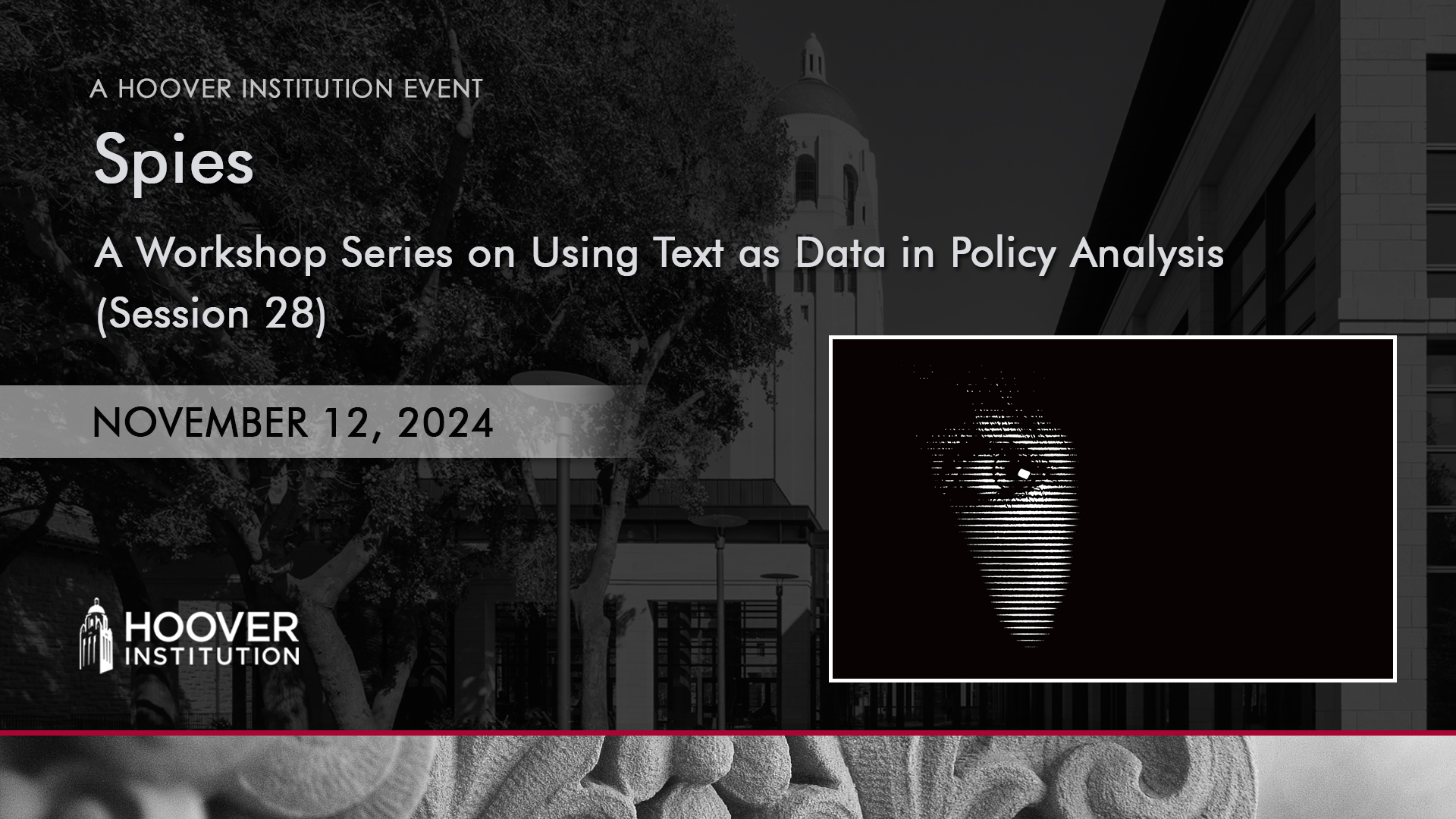
Our 28th workshop features a conversation with Milan Quentelon “Spies” on November 12, 2024, from 9:30AM – 11:00AM PT.
The Hoover Institution Workshop on Using Text as Data in Policy Analysis showcases applications of natural language processing, structured human readings, and machine learning methods to analyze text as data for examining policy issues in economics, history, national security, political science, and other fields.
WATCH THE WEBINAR
>> Steven Davis: Greetings, and welcome to the Hoover Institution workshop on using text as data in policy analysis. I'm Steven Davis, a senior fellow at the Hoover Institution. With me is my Hoover colleague and workshop co organizer, Erin Carter. Joining is one of our newest Hoover colleagues, Milan Quentel. He recently earned his PhD at Pompeu Fabra in beautiful Barcelona.
Today he's going to tell us about his working paper on spies. And I'm sure it's just as fascinating as that image we had at the lead in. So here's our format. Meanwhile, we'll take about 30 minutes to present, then we'll turn to a discussion. If you have a question or comment, put it into the Q&A box, we will get to it after the presentation.
We'll run for about 60 minutes in a recorded format, Then we'll turn off the recording and continue with a more informal discussion. For anyone who wants to stick around, Milan, the floor is yours.
>> Milan Quentel: Perfect. So thank you so much for having me. I'm going to present my project titled Spies.
This is co-authored work with Albrecht Glitz, who is at Pompeu Fabra in Barcelona, and with Sekou Kaita who is at the IAB in Germany. And my co-authors may join later to the presentation because of time scheduling issues. So in this project, what we're looking at or what we're motivated by is the fact that espionage and covered action are on the rise globally.
So on the right graph, for example, I plot you the number of detected Chinese spies in the US every year between 2000 and 2020. And that's been a very steep increase. And of course, that's not all cases, and so the FBI might know better. And they report a 1,300% increase in Chinese espionage cases over the last decade.
And today that means that the FBI opens a new investigation case every 10 hours. And so that's for economic espionage. And at the same time, there's a lot of political espionage as well, which has been central in recent conflicts, for example, between China and the US, Israel and Palestine, or Russia and Ukraine.
I brought you a few newspaper headlines, all from the New York Times, but you could have chosen any. So this one reads, allied spy chief warns of Chinese espionage targeting tech firms. That's from last year. And there's one on Chinese hackers, target phones used by Trump and Vance.
Suddenly Chinese spies seem to be popping up all over Europe. But it's not only China. So there's also this one. US accuses Russian TV Network of conducting covert Intelligence acts. Or from the other side, the Spy war, how the CIA secretly helps Ukraine fight Putin. And finally from the Israel Palestine conflict, how Israel built a modern day Trojan horse, exploding pagers, the conflict in which spies have also been very important.
And we think that's important because espionage has very large redistributive welfare effects. There's an estimate from the IP Commission from 2017 that suggests that intellectual property theft costs the United States between 200 and 600 billion US dollars per year. And there's a separate estimate that shows you the benefits of espionage for the other side.
And so this is from Walton 2023, and it says that China likely saves about 320 billion, also US dollars in research and development cost from economic espionage. So that's the first part of our motivation. The second part of our motivation is that despite the rise in cyber espionage and other forms of technical espionage over the last years, individual spies, the factor of human intelligence remains as important as ever.
This was recently confirmed by the CIA in an interview. And the reason for that is that to put it in economic language, technical and human intelligence, espionage, they seem to be complements. As you gather more information, more data, it's even more important to have individual spies who infiltrate a different country to identify which information is important and how to get it.
And with these two motivational points in mind, we're going to ask the following research question. We want to know what makes spies effective. And with that, we also want to answer what we can learn for counter espionage policies. This is a big question and there's a big challenge here, and that challenge is that data on espionage is typically scarce.
Secret services might have some of it, but publicly available, you almost find no data on espionage. And so here this paper comes in and essentially what we do is we exploit declassified data from the East German Secret Service during the course war. And I'm German myself, the Germans are very particular sometimes, they like to keep track of everything.
And so they did that in this case as well. And so what we have is the complete archive of 365,000 information pieces that were sent to East Germany by about 8,000 spies. So you can think that the blueprint for a military weapon, for example, that might be one of those information pieces.
Or alternatively, it might be a report about a governor or even a prime minister of some country and their stance towards some policy issue. And all of these information pieces, they were gathered in this archive that you see in the picture on the right, a huge computer room in East Germany.
And so this is our information on what happened on the east side, what happened in the Secret Service. We're going to combine that with what spies did in the West. And in particular we're going to obtain information on the careers of spies in their regular jobs in the West.
For example, if they were an engineer for Siemens or for IBM. And we're going to do that by obtaining CVs from Social Security and from public records. And with that data in mind, we're going to measure spy performance at the individual level as the quantity and quality of information that spies deliver.
And then we're going to pursue three objectives. First, we want to describe performance of spies throughout their careers. Second, we want to disentangle the roles of talent, access to information, human capital and financial rewards. And third, we want to discuss if there is anything that we can learn for counterespionage policies today.
And one disclaimer, a little bit of expectation management. This is all still very much work in progress, so I'm looking forward to your questions and comments later. In terms of the literature, we're adding to a literature on the economics of espionage. And in particular, there have been two papers, both by my co-author Albrecht Glitz, and they have shown the macroeconomic implications of espionage.
In particular, they show that when East Germany engaged in espionage, it benefited the firms. And industries that received economic espionage material. They find that those firms and industries were more productive at the end of the Cold War. And in particular, they show that these results are driven by the quantity and the quality of the information that individual spies provided.
What we want to answer is what makes spies effective? So we know that, apparently, espionage is important, but what makes spies more or less effective and how can it help us for counter-espionage policies? And there, we only have qualitative and anecdotal evidence so far. So there's a very large literature of historians that has studied this topic, also political scientists.
But these attempts usually look at individual spies and then try to infer more general patterns from that. We take a different approach here. We gather and analyze novel data and we write the first quantitative paper on the determinants of spy performance. And secondly, we are also relate it to a literature in organizational economics that has studied the selection, incentives, and performances of bureaucrats.
And we are going to be the first paper here that studies spice performance, where spies have a very particular job, very particular incentives that govern performance. Okay, a little bit of background. So East Germany started its espionage program at the onset of the Cold War. And there were multiple goals.
I think for the economic side, it's fair to say that the primary goal has always been to catch up with Western technology. And so here the East German Secret Service was kind of the arm of the Soviet Union into the West, into West Germany and into the US.
And on the political front, yeah, these were the diplomatic and military tensions of the Cold War. And here the key goal was to stay ahead in these negotiations, to know, for example, what the West German government was planning, intending, but also its allies. And institutional, the Secret Service's name is the Hauptverwaltung Aufklarung, and that's the Stasi's Foreign Intelligence.
On the right, you have the logo of the Stasi. And this Secret Service is often considered one of the best secret services of the Cold War, because of its particular position in East Germany with the great connections to West German and Western technology knowledge. And by 1989, there were around 1,500 active spies left.
And most of these spies were located in West Germany, but also some in Europe and in the US. Okay, so we're going to link three data sources. The first one is this archive on the 360,000 information pieces. You have one such information piece on the right. And on those information piece files, the Secret Service gathered the date of the information which spy send it in by ID and codename.
So if this was James Bond, we would know 007, and that's all that we would know. And then they evaluated each information, and in particular, they assigned a value that could be average, which were most of the information pieces, high, which were 14% of information pieces, or very high.
And both qualitative and the previous research by my coauthors suggest that this was really key and very highly correlated with how useful these information pieces were for East Germany. The second data source that we're going to use are personal records from the Stasi. And there we have a cross section of 750 spies that worked in West Germany in 1988.
And there are a couple of variables that are particularly interesting for us. For example, the Secret Service classified whether spies were motivated by ideological concerns or mostly by financial concerns. So we will look at that. But we also know at which age people were recruited, how they were recruited, and where they were recruited.
And then the third dataset, and this is where text as data comes into play in this particular presentation, are the spies' CVs in the West. And so what we do there is we're going to review or we have reviewed over 17,000 pages of historical research, books like the book that I show on the right.
These are books written by historians, but we've also checked newspaper articles and other sources from the time. And I told you that if the spy would be James Bond, from the East Germany side, we would only know the codename, so 007. And then we're going to use this review of the 17,000 pages to identify as many spies by real name as possible, as well as by birth date.
And that allows us to then match those spies in the West German Social Security records as well as to find out more about them in the qualitative literature. And to gather information on the full labor market history in particular, in which occupation, industry, firm or job those worked in, at which time, and for some spies, also their salary in the West German job, so, for example, at IBM or at Siemens.
Okay, with this data, we want to measure what spy productivity means in this context.
>> Erin Baggott Carter: Can I just ask a really quick question before we move on, Milan? This is absolutely fascinating work. So I'm curious, so you've gone from a group of, I think, 8,200 spies down to 105 of CVs that you found.
Can you comment a little bit on any selection bias that might sort of operate in that, in that winnowing? Thank you.
>> Milan Quentel: Yes, so that's very important, that those 8,000 spies, they're really the universe of all spies. We know that these must have been all. And the 105 plus 165, so about 250 spies, they're positively selected.
So these spies are more famous, more productive, better known in a way, okay? So we will go through these analysis pieces and they will all draw on different samples, okay? And so in the paper, what we do is we discuss from which sample, which inference is drawn, and how much that should extend to the general sample.
But in particular, for those very positively-selected spies, we will only compare them to other very positively-selected spies. And so there's no reason why we should think that these very good spies would be compared to worse spies. But it's true that, of course, very good spies might work in a different way than very bad spies.
But one key important information is that, I think, the top 5% of spice, they provided around 60 to 70% of the high-value information. So this is also the sample that we should be most concerned about as the policymaker. I'm happy to talk more about it in the discussion.
So we're going to measure spy productivity, and we're going to measure spy productivity in two ways. On the left, I show you the quantity of information. This is the information that spies delivered per year. This is on a log scale. And so most spies really delivered between zero and ten pieces per year.
But there's also a good bunch that delivered between 10 and 100 pieces of information per year, as well as few outliers even into the thousands of pieces per year. And on the right side, you see the quality of those information. Remember that I told you that there is this scale from 1 to 5.
5 means extremely valuable, 1 means not very valuable at all. The mean is 3, and most information work were between 2 and 4. And the real good outliers, the ones that really pushed East Germany forward, they are at 5. So these are the top value information pieces. And to give some contextual knowledge for that, so here on the graph on the left, I should show you the number of information on the x-axis and the value on the Y axis.
And each blue dot as a spy here and the red dot, that's one particular spy and that's TOPAS. That was his code name, also called by real name Rainer Rupp. And he was East Germany's top source at the NATO headquarters in Brussels, working on military strategy of NATO, for example.
And he delivered about 1,000 information in total of average value of say 33.8. But then there's also this one, for example, SCHULZE, Peter Kohler, he worked at Texas instruments in the US mostly on microelectronics. There's been this one Dr. Gabrielle Gast called GISELA, and she was at the BND, the West German Secret Service.
And she's been probably the most prolific spy of East Germany in the Cold War. Or here, for example, Jeffrey Carner, this is someone from the US army called DEVIL, and he worked in West Berlin on US surveillance in, yeah, in West Berlin and signals intelligence. And so you see that there are all these different spies.
They differ vastly in their productivity, and now we want to find out why. Okay, a little bit of a theoretical motivation. We asked ourselves, when do spies perform well? So this is in part drawn on our own intuition and in part drawn on the historical literature. And so we think that there are at least five factors that matters.
Think about why IT is the productivity of a spy here. And then the five factors that could matter are the talent of the spy, often unobserved, the access of the spy to information that can depend crucially on which job the spy is working in. Espionage, specific human capital that the spy gathers by spying more, motivation and financial rewards.
And then particular shocks, including espionage demand shocks, when the Secret Service said this particular topic is important to us this year, as well as supply shocks when there was an increase in available information, for example, because a conflict heightened. First part, we think about recruitment. So what we do now, we go through the entire spy career and we try to understand a little bit which spies were better and which were worse.
And so looking at recruitment, we know whether the spy was recruited in the west relative to in East Germany, whether they were recruited by a spy relative to an agent of the Secret Service, and at which age they were recruited. So what the results show here, this is in terms of quantity.
Spies recruited in the West are about as productive as spies recruited in the East, maybe even a little bit less. Spies recruited by a fellow spy, they were much more productive. So if it was someone that was already in the espionage business and they found out about a potential recruit, they were apparently much better at identifying talent.
And so these spies deliver about 30% more information per year. And then there is the age at recruitment. And here, for the quantity of information, we don't see anything. For the quality, we see a similar picture. And in particular here, we know that spies were recruited by a fellow spy.
They deliver information that is about 0.1 that receives about 0.1 higher value grades by the East German Secret Service. And so that's very meaningful, because the very, very high quality information, they were extremely important. And so that's about a 10% chance to move from a high quality information to a very high quality information, each information.
And the other thing that's noteworthy in this table is when you look at the row of age at recruitment, you see that there are significant negative effects in the first three columns and then not anymore. And so from column 1 to 5, we subsequently introduce control variables in particular year, experience, occupation and industry, fixed effects.
And so this negative coefficient without any controls, that seems to suggest that spies who were recruited at a younger age, they tend to provide better information later. But that effect becomes statistically indistinguishable from 0 once you include occupation fixed effects. And our idea, our hypothesis here is that probably young spies were better, because they were recruited at a time where the Secret Service could still push them to interesting organizations and occupations that would then later be valuable.
And we have one particular case study that shows exactly this pattern. So this is TOPAS, I told you about him before. And TOPAS was recruited as a student in 1967. So at that time, he was still in West Germany. And so this is kind of the first year you see in the graph on the left.
And then for the seven years where TOPAS was a student, he didn't provide any information which you see in the red line, but he was already being paid and trained by the Shazi. And then he was first a student in Mainz for a couple of years. That's where they hired him.
Then they moved him to Brussels, and they had something in mind, of course. And then he became a researcher in Brussels. And then ten years after they had hired him, initially they were able to place him at the NATO headquarters in Brussels, where TOPAS would become the most valuable source on military strategy, probably on the entire eastern side during the Cold War.
And so the first hypothesis that we have here is that young recruits, they might be better because the Secret Service can place them in invaluable objects. The second hypothesis that we have is that promotions and job changes in the west give spies access to more and better information.
So you can see that for the first job that he worked in as a researcher between 1974 and 1977 to the next job at NATO headquarters, you see how the quality of the information provided jumps very rapidly by almost 0.7 points, or about three standard deviations. So that's a very huge effect, and that seems to be driven by the fact that TOPAS moved objects moved to an important institution.
Okay, in statistical tables. So this is the first hypothesis. Are spies recruited as students systematically better? Here what we find that in general, yes, a little bit. Spies that are recruited as students, relative to spies that are recruited after they finish their education, provide about 20% more information and not more valuable information.
But for political and economic spies, this is completely different. So for political spies, we find that they provide more and better information, 32% more information and information that is 0.1 value points higher. And for economic spies, we find that they provide worse information if they were recruited as students.
So we have not been able to dig into this more. But our current hypothesis is that for political spies, it matters a lot at which institution and at which job you work in. Whereas if you would just try to place an economic spy at, say, Microsoft today, it's not as clear whether that spy would then eventually obtain a position that is of use for the Secret Service.
And so what seems to make more sense there is to hire spies when they are already in the good positions. The second hypothesis was that promotions matter. One caveat here is that we cannot measure promotions within the same job. We don't have information on that. But we know when spies switch their firm or their institution.
And so with this event study methodology, we find that that's indeed the case. So after switching institutions, switching firms, we find that spies provide more as well as better information. And for us, that suggests that it does not only matter where you initially placed the spy, but also the full career over the CV of the spy seems to matter.
And each time they get promoted, they get more access to more and to better information. Okay, then we also wanted to look at espionage specific human capital. And so what we do here is that we plot on the left the number of information, the log number of information that spies provide over their career from years 1 to 15, all relative to the first year, which is here a zero coefficient.
And on the right, we do the same with the quality of information. There's one interesting difference here, and that is that when you look at the quantity of information, spies seem to get gradually better throughout their entire career. So at least until year 13 or 14, we find that each year the spies provides more information, either because they get better at spying, or because they keep getting promoted, they keep getting access to more information.
And that makes them so successful in terms of quantity. In terms of quality, the picture looks different. In terms of quality, you find that between the first and the third year, so within the first two years, the spying increases the quality of the Information very rapidly by 0.2 value points.
So that's a 20% higher chance to go from a valuable to a very valuable information. But then between years 3 and 15 or the end of the career, for many spies, there is no increase in value anymore. And so that seemed surprising to us. And what we did next was that we decomposed this quality measure into two things.
So on the left, I show you the quality measure again, you see again that this increased in the first two years. On the right, I show you the quality of information pieces that were not delivered by the same spy, but by different spies, and that were on the same topic.
On the same topic as measured as by the same keywords that were attached to the information. So, for example, if a spy delivers an information on military technology, we can calculate what was the average value of military technology information excluding that spy. And we call that a measure of relevance because it's not about how good the spy is given a particular topic, but it's rather about whether the spy reports on the right topics.
And so here we see that there's also a very sharp increase in relevance over the first two years. And from the two graphs, you can calculate that about 75% of the quality increase in the first two years really comes from spies shifting across topics and learning which information seems to be relevant for the Secret Service and which information seems not to be relevant.
Okay, last section of the paper. This is about motivation and financial incentives. So here, even today, secret services think a lot about the different sources of motivation that spies have. So the CIA, for example, has this classification system called RICE, which stands for reward, ideology, coercion, and ego.
And the East Germ Secret Service, they had a similar, yet a little bit more simple system. They recorded the first two of these points, whether spies were financially motivated, which is called reward here, and whether spies were ideologically motivated. So this is the next thing that we analyze.
And here we find that financially motivated spies, if anything, they deliver a little bit more information, say between 10 and 20%. But it's important to note that this is imprecisely measured and sometimes varies depending on the covariates that we include in the regression. But in terms of the quality, we see a very sharp increase.
So spies that were financially motivated, they seemed to deliver information that was 0.07 to 0.11 points higher in the value classification system of the Secret Service. And so, that's a first interesting insight because, often, secret services today talk and think about ideology as being one of the core motivations.
And we show that even in a context where ideology was very important, the cold war, what still seems to motivate the better spies is money. Then we wanted to understand whether spies that are better, that perform better, if they're also being compensated more by the Secret service. And so here on the left, I plot you five separate regressions of compensation per year in log terms, on the number of information per year also in log terms.
And now the five separate coefficients stand for low quality information to very high quality information. And here we see that the only type of information that actually predicts how much spies earn is very high quality information. And that type of information is also depicted on the right. Each bullet point here is a spy, and you see that the spies who deliver more high quality information per year, they're also compensated more.
And the the elasticity here is about 0.3. And now we would love to know how much spies react to these financial incentives. And the ideal experiment would here Would be to vary the compensation that spies receive exogenously, but that's very hard. And so what we do instead is we exploit variation in spice outside options in the regular labor market.
And so what we find here is that spice for which the labor market improves, for example, because the lock median wage in the occupation by industry of that spy increases over a time period. Or because the unemployment rate falls, these spies deliver more information. Or put differently, spies provide fewer information when the regular labor market situation improves.
So there seems to be the substitution between information quantity and between how well someone is doing in their regular job. And that's relevant, we think, for counterespionage even today, because of the following case study. So this is one spy called Burke, full name Wilhelm Paproth and he was a systems engineer at IBM in Essen.
And according to historical sources, he was one of the two spies that kickstarted the East German computer industry back in the 70s. And so there are estimates from the previous paper by Glitz and Meyerson that show that East Germany saved about 12 million euro in research and development costs per year, simply because they already knew, due to the spy Birke, how to construct very basic computer parts.
And they had learned that from IBM in West Germany in Essen. And our thought experiment is, what if the spy had earned more money at IBM, so the average salary, annual salary in his position at the time was €52,000. And given our estimates before, we can show that a 10% increase in wages, which would have been €5,000 per year, that would have led to a 5% decrease in information, and that would have been valued at about €600,000 per year.
And this is just one case, but it goes to show how far you can get in back of the envelope calculations once you know the elasticity of espionage with respect to financial compensation. So if you believe that that elasticity stayed the same for modern context, you could use it.
Yeah, to understand where secret services today should invest into better salaries and thus less espionage. Okay, I'm essentially out of time, so I want to conclude. We show that unobserved talent matters, we show that access to information matters, and also how much. In particular, the placement of young spies, as well as when they climb the career ladder.
We do show that human capital, espionage, specific human capital seems to be important, and especially the first years of the career are formative. And we show that financial incentives matter. And with all of that together, one can look at counterespionage lessons for today. I don't have so much time to go into this now, but it's also the last slide.
So it will stay open for the discussion and we can get back to it later. But in particular, we think that spy recruitment networks at universities might be very important back then and today. We think that there are implications of our paper for the screening and monitoring of employees.
And we do think that there are implications of our paper for optimal wage setting in information sensitive organizations given the elasticity, the wage elasticity of espionage that we calculate last bullet point. These are all tentative conclusions, I'm super happy to talk more about them in the discussion. You can contact me@milan.quentel@gmail.com or come directly to my office, which is 342 at the Herbert Hoover Memorial Building.
So thank you very much. And yeah, I'm looking forward to the discussion.
>> Steven Davis: Okay, thank you, Milan. That was super interesting. I have a bunch of questions and comments, but let me put three on the table quickly. First, the last point about wage setting and information sensitive organizations.
>> Milan Quentel: Yeah,
>> Steven Davis: I guess I'm not persuaded that that's an effective way to deter spying because I start from the premise that most people in these organizations are not spies, not on the margin of becoming spies. And so paying them more without knowing who's to spy. Of course, if you knew who was the spy, you just take direct action.
If you don't know who's to spy, paying them more is a very low powered way to deter espionage. So I think it's worth factoring that into your calculation. This doesn't seem like the way to go.
>> Milan Quentel: Can I reply?
>> Steven Davis: Yeah, go ahead.
>> Milan Quentel: I completely agree with you.
And that's part of the welfare calculation that a Secret Service would have to make, right? So there might be some jobs where only very few people have access to a particular type of information. And if it's very few employees, then it might matter and you might want to pay a loyalty wage premium so that the people spy less.
And in fact I think that's already happening at very important organizations such as NATO for example, at top levels. The question is how much? And that how much depends crucially on the elasticity that we provide here.
>> Steven Davis: Yeah, understood. But you know, like one of the examples you gave was the guy who was the reporter or however you say it.
I mean he's, that's not a super high level position, but he obviously said it in lots of discussions. So it, it's just going to be a very low powered way to deal with the issue. Let me ask you about another thing on ideology versus reward. So you showed evidence that the quality of information, if I remember correctly, and Maybe the quantity as well is more sensitive to compensation than ideology.
Did I get that right?
>> Milan Quentel: Yes, so the spies were financially motivated, they are better in terms of quality.
>> Steven Davis: Yeah, so I believe that, but it kind of raises the question about the initial recruitment effort. I'm guessing, and I don't know whether you have any evidence on this, that at the recruitment stage, ideology is really a key factor rather than future promised compensation.
And overall, the picture of who becomes a spy and why, I'm doubtful that it's mainly financial considerations. Because if it were, then that all it about, then there are millions of potential spies in a society like the United States. I doubt that's true. So somehow the overall model has to be more sophisticated than that, may have elements, of course, it has elements of compensation, and they may interact with ideology.
And you also mentioned ego, you know, I guess, which I interpret to be the idea that I'm somehow important at the center of things, and that's why that was part of the CIA's model. So what's your take on the broader role of ideology and ego to become a spy?
>> Milan Quentel: Yeah, thanks, Steven. So that's a very good point. From the first point, what I read into. To your comment, I think is that the selection of spies matters, of course. And if it's easier to recruit ideologically motivated spies, because there were a lot in East Germany. Then simply because of selection those spies may be worse, right?
Than the financially recruited spies. And that's important to keep in mind here, right? So there I completely agree with you. On ideology, I can say we haven't done many analysis. One analysis that we've done, but that I haven't showed you is that ideology is great because it's easy to recruit spies.
But it's also dangerous because you can show that in the last five, six years of the Cold War, the information delivered by the ideological spies really went down. Whereas the information of the financially motivated spy stays constant. And so these systems were in a conflict. And once you realize that your own system is maybe not the dream, the socialist dream that you thought it was, ideological spies get worse.
>> Steven Davis: Well, that's a super interesting observation.
>> Milan Quentel: Yeah.
>> Steven Davis: It has clear implications for the present day. To the extent that the United States or the western economic and political model is viewed as successful, that may by itself discourage espionage activities. And we've seen this play out with China.
The shine on China's so called economic model, if you wanna call it that, has diminished considerably really the last three years or so. And presumably that's, according to what you just said, that's also bad news for Chinese espionage efforts, other things equal. So that's fascinating. I've got more questions and comments, but there may be others.
So let me turn to Erin and then we'll go to the floor.
>> Milan Quentel: Sure.
>> Erin Baggott Carter: Fantastic, thank you, Milan. This is an absolutely fascinating project. So I have a bunch of different questions, but I'll just pick one to get us started. So I'm curious about how you think about violence and repression and all of this.
And I'll start by way of an example. So in the case there are all these sort of facts perclaining out about Chinese espionage today. And one of the really interesting things I heard was that there are people who have committed major felonies for just like $10,000 for example.
And when they're caught, they know what in sort of the interview, the question is, why did you do such a major crime for relatively little money? And the answer that many of these people have given is that, well, I know that if I had said no, they would have done something really bad to me, right?
So I might as well get the small amount of money because I'm going to be penalized if I don't anyway, so I'm curious if you have any data to look at those sorts of dynamics. I mean, obviously not as though you can just quit being East German spy easily if you want to, and go take that nice job at IBM.
So I'm curious if you have any data that you can use to get traction on that or if you have any intuition, more broadly speaking, thank you.
>> Milan Quentel: Yeah, so I find this coercion part super interesting myself. From our reading of the historical case studies, it seems that the East German secret service was a relatively friendly secret service.
So there were very few cases of coercion. And the cases of coercion that exists were very soft cases of coercion. So there were a lot of female secretaries that fell in love with an agent from East Germany and then were either misled or wanted to stay in that relationship.
So that's maybe a soft case of coercion. So in that sense, I think this particular context is not the best to study coercion among spies. But I completely agree with you, I wouldn't rule out that that plays a huge role in more recent conflicts. I could totally see that.
>> Steven Davis: Brett Carter has a question, is Brett able to speak or, no? You wanna take his question, Erin?
>> Erin Baggott Carter: Sure, yeah. So Brett has a comment in the chat box here. He says this is really fascinating work, I'm curious if there is archival evidence that supervis that spies recruited by other spies were systematically better than others.
If so, to what extent did they incentivize this and to what extent were these incentives successful? Were spies recruited by other spies more or less likely to recruit still other spies and sort of ever expanding network of spies?
>> Milan Quentel: Yeah, that's a very good question. Thank you. So right now we don't know so much yet about the case officers of spies, but we have data incoming on that.
I'm not sure if we will be able to speak exactly to your question, but for sure we will be able to say more about how case officers interacted with their spies, how that increased quality and quantity. And it's true, it would be interesting if in that new database we could also observe who hired who.
That would be super interesting. I would see if that's possible.
>> Steven Davis: Thank you. And how about Hans Lueders, can we let him speak?
>> Hans Lueders: Hi everybody, can you hear me?
>> Steven Davis: Yes, we can. Thanks, Hans, Go ahead.
>> Hans Lueders: Awesome, thank you. This is super interesting. Thank you for this presentation.
So I have two questions. So my first one is on kind of under what conditions and at what point spies drop out of your data. And, if you've looked at kind of like, what correlates with that from sort of survival analysis. Cuz my concern is that just, you know, the low quality types drop out at some point.
And that might explain some of your findings regarding kind of like this increase in the quantity of information that spies deliver later on. And then my other question is just like, probably from our cable sources, from your own kind of, background reading. Do you know what the Stasi valued more quality or quantity of the amount of information delivered?
So from my own kind of work with archival data on, the Stasi, not on spies, but on kind of informal collaborators, it seemed like what the Stasi really valued was just having as much information as possible. Cuz you could always use some sort of information. But I'm wondering if that actually translates to spying and then I guess, also kind of.
I would love to hear some more qualitative insights and how the Stasi kind of decided who to allocate where and what factors kind of correlated with that. But yeah, super interesting. Thank you.
>> Milan Quentel: Many, many great points on the allocation problem of spies. This is something that we intend to study in a separate project to think about, if you're the Stasi and you have to manage all those spies and you know, your demand function, let's say, so we can estimate that.
Where should you send spies, how should you invest into them? What's the research problem here? The first point, the survivor analysis, is super interested, interesting. And I hope we can do that at some point. For sure it's true that the worst spies, they drop out in the beginning and the better spies stay.
I don't think of that so much as a caveat, but more of an important finding in itself because as a secret service, if you want to provide a lot of good information in the long run, one of our key findings is that it's a good strategy to keep your spies as long as possible.
And then there are also interesting trade offs here, right? You can engage in more risky information seeking, but that might mean that the spy gets caught eventually and then you lose them as a source. And so these are all very interesting points that quantitatively we cannot say a lot about yet, but hopefully at some point.
And the second point was whether they were more interested in the quantity or the quality. So they were really, I think, both in some sense. So for sure, they. They were gathering a lot of information that was also sometimes extremely useless. So there was one secretary in a library, a public library in West Germany, and the only thing that she would do was taking photocopies of all the publicly available books in West Germany and send them over because they were publicly available in West Germany, but not in East Germany.
Arguably these were not particularly valuable information. But then we also know that the technological convergence and the success of East German firms, that's really driven only by a select number of very valuable information pieces. And I cannot prove it, but I'm relatively certain that the GDR had at least some hunch that that was going on because these are the spies that they paid particularly well.
>> Steven Davis: So just on the selection effect, I mean, one thing you could do that's very straightforward is just to construct your quantity and quality profiles with respect to years of service in the spy activity using adjacent years of fixed samples. So you take the first two years and it's basically like a chained index almost.
So that at least cuts out the most immediate and direct effect of selection on the quality and quantity indexes. Just a standard type of chained index approach that would be useful to do.
>> Milan Quentel: No, that sounds good. Let me make one correction because if Hans question was specifically over this plot that you're referring to, Steven, which showed the number and quality of information between year 1 and year 15.
So there is no selection in that plot because we condition on all spies reaching at least 15 years.
>> Steven Davis: Okay, so that's an alternative approach. The pros and cons of that approach versus the one I suggested is you've got more data in the early years under the approach I suggested.
But your approach also deals with selection. So thank, thanks for that clarification.
>> Milan Quentel: No, but we'll try your approach as well, because your approach has the advantage that it preserves much more data, right?
>> Steven Davis: Exactly, exactly.
>> Milan Quentel: Only on the spies with very long careers, right?
>> Steven Davis: And that can entail a different kind of selection.
>> Milan Quentel: Exactly like the selection.
>> Steven Davis: Those very long career spies have just different life cycle profiles, which they may. And that's an interesting finding in and of itself if that's true. So this is related to something you've already said, but maybe this is the next paper. But you didn't show us any information about the overall topical distribution of the spy content that was coming back and whether it's evolved over time.
>> Milan Quentel: I feel a bit bad about that because I hinted that that would be the case. And then you invited me to this text as data workshop. And then this part of the evidence didn't really make the cuts because one of the problems that we face is that we have a lot of separate pieces that are super interesting to us, but getting them into one narrative is sometimes more difficult.
And so now we're writing one paper on how good spies were and what made them good. And then there might be a separate paper on which topics they worked on and how that evolved over the time. And so I still find that they're super interesting questions. I'm looking forward to diving into text and topic models, but I'm sorry to say that they were not in here yet.
>> Steven Davis: Okay, well, we'll look forward to that. So we've got a couple more questions online. Norman Neimark. We let Norman speak.
>> Norman Neimark: Okay, thank you very much as extremely interesting. I was thinking, as you were speaking about the internal spying service, which of course had many different levels to it, including, you know, these, you know, the people who were just sort of casual spies.
And you have sort of four or five different levels of spying, right? Some of which, you know, had nothing to do with payment whatsoever. And then various, various levels of payment. So I was thinking in the various levels of ideological and sometimes bullying of sorts, right? I mean, you would, you know, you would encourage people.
So you had different ways of recruiting and maintaining spies which were pervasive in society. So how does that work abroad? I mean, is there just this one level of, you know, spy, spy, or are there many different levels of people who cooperate with the, with the Stasi to provide information?
>> Milan Quentel: So as you very correctly said, there's a lot of heterogeneity in how good spies were, both in terms of how often they send over information pieces and also in terms of how high the quality of those pieces was. And that's reflected in the payment. So that's true for sure.
There are some spies that are, that were more casual. There were some spies that were extremely casual. So their only job was to live close to some closed military area in, say, western Germany and report when planes were going in or going out, right? So this is the less informative type of espionage that I don't think will be super crucial either today or in the case back then.
I don't think that that drives so much, say, technological convergence or diplomatic conflicts. And then, as you correctly said, all the way up to the very, very good spies who really made spying their main job, despite NATO that he worked at NATO, sure. But he earned most of his money through spying.
And that seemed to be his. Yeah, his key, his key drive. There's one particular spy that I showed you who worked for the US army in West Berlin. And what he did was he intercepted East German messages for the US army actually, for NSA. But then he would relay that back to the East German Secret service.
So they knew exactly what the Western side knew. And that spy earned three times as much in spy compensation as they earned from the U.S army. And then you can really see how those financial incentives tie in. And that is super. I mean, I'm not sure what I would have done in his situation.
You know, like, it's a lot of money, so. Yes. So there's the full heterogeneity between very casual spying and very successful high caliber spice.
>> Speaker 6: Hey, thanks. This is great research. I had two questions. I'll just ask one. All of the roads seem to lead to the data and value that the East German Foreign Intelligence Service assigned to each agent's work.
So I'm wondering, how confident are you in the truthfulness of this data because we know in other spy organizations, especially in repressive regimes, there's a high degree of lying about all sorts of things. So just curious about how you assign value to that data.
>> Milan Quentel: Yeah. So we were positively, very, positively surprised ourselves because you might think exactly that there's a lot of political economy going on.
There might be a case officer who lobbies for their information to have particular high value so that the compensation is better, for example. So that's not going on because it seems very unlikely that that's going on because. Because the units were really kept separate. So there was the case officer.
The case officer would send in the information, say the blueprint of some technology. Then there was a separate unit for evaluating that. And these people would often personally not even know each other. And that evaluated the information then and sent back the grade. And so we know from this literature on the macroeconomics of espionage that it was really only the very valuable information pieces that drive technological convergence across sectors.
So the industries were, where East Germany engaged in, for arguably exogenous reasons, engaged in more espionage. And where there were more very valuable information pieces are also the industries where TFP catch up happened. And the same is true at the level of East Germ firms. And so we will never have a perfect way of verifying that there was no lying going on, so to say.
But at least the data speaks for us that those very high quality information pieces, they were driving value, at least on the economic side.
>> Steven Davis: Okay, we're running short on time, so we got another question, I'm just going to read it. Is there any documentation available on the work of Soviet spies during the Second World War?
So this is tapping your knowledge of the literature here, Milan?
>> Milan Quentel: Yeah, no, so this is, I mean this is a great question. I will not be able to answer it 100%, but I have a hunch and that hunch is that no. And so this East German context was very special.
And why was that? Because East Germany had, was the only government in history, I believe, that suddenly disappeared, had a very good secret service before and then became part of another country that had no particular interest in keeping those secrets secret. So when you look at the, the KGB, for example, or the Soviet intelligence service at the time and that going down, Russia as kind of the follow up state, they had a particular interest to keep everything safe.
Also the Americans after the Cold War, any information that we know about Eastern German spies in America was typically tried to be kept secret by the CIA and by the FBI because these states continued, but East Germany did not continue. And so we know about that information and so for the Soviet Union in World War II, I would think that the same is going on, right?
That there was, after the win by the Allied and the Soviet Union, there was a lot of incentives to keep the secret service operating as previously. And yeah, so I would be surprised that that information exists to the same degree, but I would be happily surprised. So let me know if you find it.
>> Steven Davis: That's a good point. I mean there are, there are Archives in the United States that eventually are supposed to become open after 50 years or so. But I don't actually know whether that applies to Secret Service espionage type activities. Maybe before we even had a CIA. Is that the case?
I mean, I guess the old OSS stuff is that now migrated into the public record or not?
>> Milan Quentel: So that's. You might know this better than I do, but what I know is that there is more and more information coming up from what the CIA did say in the 60s and 70s in terms of corporate action in, say, Latin America, for example.
I looked into this once. I think it would be a lot of text as data work to get data out of that, that can be analyzed. But that is not to say that it's not interesting, so that it could be very interesting to see how.
>> Steven Davis: Yeah, for sure.
There's a lot of. It's not always a very pretty picture during that era, whether from CIA activities or KGB activities. Erin, you have any more questions to put on the table before we wrap up here?
>> Erin Baggott Carter: Yeah, sure. This is fascinating, and I have a bunch of different questions, but I'll just pick one.
So I'm curious, have you looked at spies getting caught? You know, because you have these some that are known from the public records here. Have you looked into the determinants of getting caught or to the extent you can see variation in strategies or any differences between, of course, many spies who don't get caught, de facto we don't know much about them.
But is there anything that you can glean from the data that you have about that?
>> Milan Quentel: Yeah, so that's interesting. So what we do observe in the data, of course, is if a spy disappears suddenly, right? And that might be because they were caught and we don't know anything about it publicly, or it might be because the GDR retracted that spies because they were concerned, or it might be because the spy decided to stop by themselves.
And so with that information, it's less clear. Would be more of an analysis on who drops out eventually. But then we could also collect data on the spies that were caught. And that data sometimes exists. The newspaper articles on that, for example, their historical sources. Anecdotally, we know that there are a lot of spies who were caught at once, for example, because there was one major spy who went over to the west and kind of told them about all of these smaller spies or because they infiltrated a whole network and through that they were able to identify multiple spies, but for now, that's about the only thing that I can say.
But it would be super interesting. So, yeah, maybe.
>> Steven Davis: Okay, great. We're gonna thank Milan for a fascinating presentation and we're looking forward. There's lots more work to come in this space, it sounds like, and I personally look forward to that. I'm sure many others do as well.
So thanks so much, Milan, and we'll turn off the recording now. Anyone who wants to stick around can. We'll have a less formal discussion. Thanks very much. Take care of everybody who's signing off now.
>> Milan Quentel: Thanks for having me.
ABOUT THE SPEAKERS

Milan Quentel is a Hoover Fellow at Stanford University’s Hoover Institution. In his primary research agenda, he studies the economic implications of the climate change transition. A particular focus of his work is to understand the aggregate and redistributive welfare effects of renewable energy policies and to support policymakers in designing an effective and just climate transition. In a separate research agenda, he studies espionage using historical data from the Cold War to inform counter-espionage activities in the 21st century. He holds a Ph.D. in Economics from Universitat Pompeu Fabra in Barcelona, Spain.

Steven J. Davis is the Thomas W. and Susan B. Ford Senior Fellow at the Hoover Institution and Senior Fellow at the Stanford Institute for Economic Policy Research. He studies business dynamics, labor markets, and public policy. He advises the U.S. Congressional Budget Office and the Federal Reserve Bank of Atlanta, co-organizes the Asian Monetary Policy Forum and is co-creator of the Economic Policy Uncertainty Indices, the Survey of Business Uncertainty, and the Survey of Working Arrangements and Attitudes. Davis hosts “Economics, Applied,” a podcast series sponsored by the Hoover Institution.

Erin Baggott Carter is a Hoover Fellow at the Hoover Institution at Stanford University. She is also an assistant professor in the Department of Political Science and International Relations at the University of Southern California, a faculty affiliate at the Center on Democracy, Development and the Rule of Law (CDDRL) at Stanford University’s Freeman Spogli Institute, and a nonresident scholar at the 21st Century China Center at UC San Diego. She has previously held fellowships at the CDDRL and Stanford’s Center for International Security and Cooperation. She received a PhD in political science from Harvard University.




















